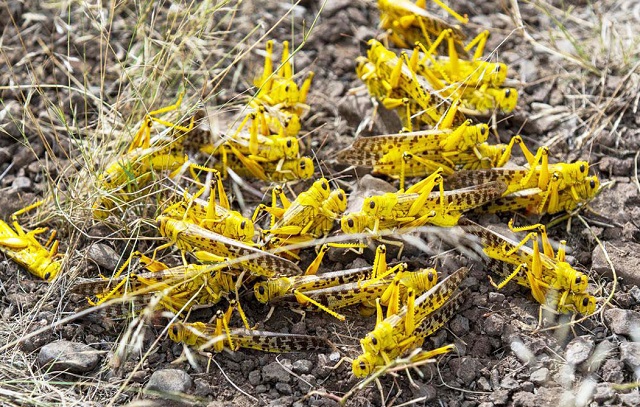
Damage to crops and pasture already reported across Kenya, Ethiopia and Somalia
Kampala, Uganda | RONALD MUSOKE | Humanitarian agencies are warning of a humanitarian catastrophe in eastern Africa as a result of the ongoing desert locust invasion around the region.
Eastern Africa hosts about 14 million refugees, the majority of whom rely on humanitarian aid to survive but funding is already short of what is needed to support these communities, even without the current locust threat.
Last year, refugee response plans for Uganda, Ethiopia and Tanzania were less than half funded and these figures were already expected to fall further in 2020.
Nigel Tricks, the Norwegian Council’s regional director for East Africa says a humanitarian catastrophe is looming in East Africa if funding to tackle the locust invasion is not secured now.
“This region has opened its arms to a huge number of displaced people, with millions already hammered by climate shocks and conflict,”he said.
Host communities and the wider population are already affected by recurrent drought and floods that destroyed crops and livelihoods last year. Around 28.9 million people are in need of some kind of aid across the region because of drought and a lack of food.
The UN’s Food and Agriculture Organization (FAO) has already appealed to donors for an additional US$62m on top of the US$76m requested last month.
David Beasley, the World Food Programme’s executive director recently said that preventing a catastrophe in East Africa is a far better investment than responding to its consequences and impact on the lives of millions across the region. He said if donors do nothing now, WFP will need up to 15 times that amount—more than US$ 1bn—to assist people devastated by losing crops and livelihoods.
The humanitarian agencies’ calls have come at a time when FAO is warning of a new influx of locusts since millions of eggs are hatching and will swarm and perch in farming areas placing the March to May planting season at serious risk. If left unchecked, the numbers of crop-eating insects could grow 500 times by June, FAO recently warned.
The regional Food Security and Nutrition Working Group (FSNWG) warned in an update on Feb. 14 that desert locust swarms are now multiplying across Somalia, Kenya and Ethiopia and more swarms have already been observed in Eritrea, Djibouti and northeastern Uganda.
Given favourable forecast weather conditions, swarms are expected to increase in areas already affected, as well as spread to neighbouring areas, noted another update from the group which includes FAO, WFP, the Famine Early Warning Systems Network (FEWSNET) and the Inter-Governmental Authority on Development (IGAD).
FAO noted in a statement last month that the situation “remains extremely alarming” in the Horn of Africa, more specifically in Ethiopia, Kenya and Somalia where widespread breeding is in progress and new swarms are expected to form this month.
FAO said swarms of desert locusts which are unrelated to the ones currently wreaking havoc in East Africa had recently made significant movement over the Arabian Peninsula and had reached both sides of the Persian Gulf.
FAO forecasts that the March-April start of the long rains would prompt the locusts to breed afresh and spread even further. Damage to crops and pastures are already being reported across Kenya, Ethiopia and Somalia, the three most affected countries, but losses may quickly spread to other neighbouring countries, particularly Djibouti, Eritrea, South Sudan, Tanzania and Uganda.
 The Independent Uganda: You get the Truth we Pay the Price
The Independent Uganda: You get the Truth we Pay the Price


